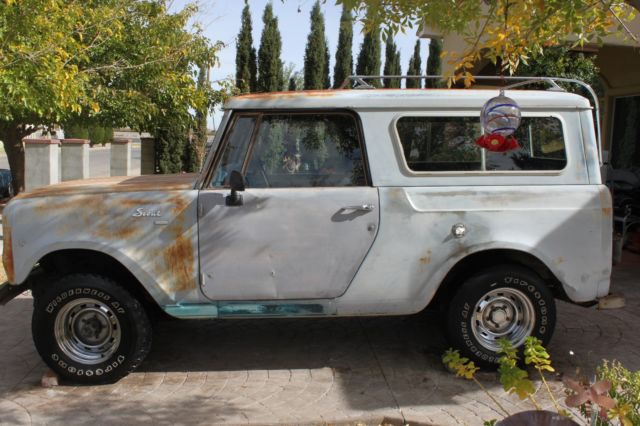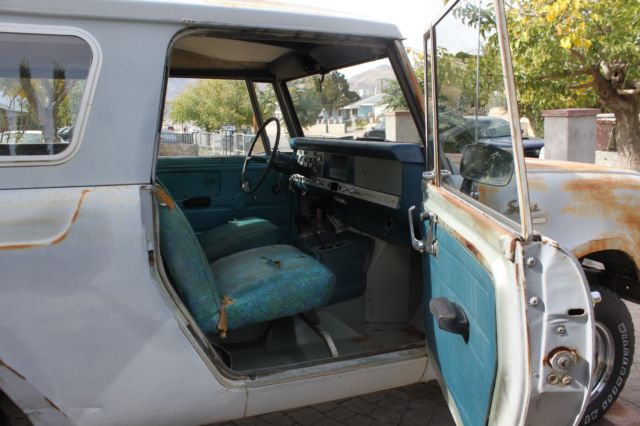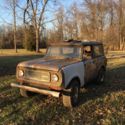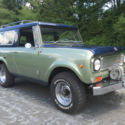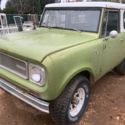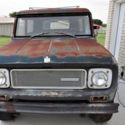1970 International Harvester IH Scout 800A Doll Up Aristocrat - Project
| Make: | International Harvester |
| Model: | Scout |
| SubModel: | Aristocrat |
| Type: | SUV |
| Trim: | 800A |
| Year: | 1970 |
| Mileage: | 58,878 |
| VIN: | 784827G367368 |
| Color: | Blue/Silver/Chrome |
| Engine: | 304 V8 |
| Cylinders: | 8 |
| Fuel: | Gasoline |
| Transmission: | Automatic |
| Drive type: | 4WD |
| Interior color: | Blue |
| Drive side: | Left-hand drive |
| Vehicle Title: | Clear |
| Item location: | El Paso, Texas, United States |
1970 International Harvester Scout 800A Additional Info:
1970 International Harvester IH Scout 800A Doll Up Aristocrat - ProjectHere is another great project vehicle in excellent condition. This is a 1970 (May 1969 build date) IH Scout 800A Aristocrat Special Edition. I ordered the Line Setting Ticket for this Scout that confirms it is one of 2,500 Aristocrats built by IH. By now there are fewer than 2,500 in existence making this project Aristocrat worth the investment.
A previous owner sprayed gray primer over the original two-tone paints, you can see the original paint in the interior cabin. There is almost no rust on this Scout, some very light surface rust. There are some dents and scratches throughout but the metal is heavy gauge and will straighten out beautifully.
These Aristocrats used redline tires with the IH chrome rally rims, a very elegant Scout indeed.
Summary:
> In need of total restorations to include body work, paint, upholstery, etc.> Original IH 304 V8 starts and runs> Borg Warner T39 automatic transmission is locked up> Transfer case may need to be rebuilt> No warranty on drive train or 4x4 system expressed or implied> Has one original IH locking hub (passenger side front tire) and 1 warner locking hub (driver's side). The IH locking hub needs to be rebuilt, both front wheels spin freely> The glass is mostly original and in great condition except a couple of dings in the windshield> SUV includes the original radio that is not installed, will need two knobs, they are missing> All dash knobs present> Regular brakes work to aid in shipping/moving, emergency break does not work> All tires hold air but are too old and you will need to buy new tires for safety> You will need a winch to load this Scout> Clear Texas title
YouTube video:
https://youtu.be/AkQzmcwQlew
From Hagerty Insurance webpage:
1969 International (IHC) Scout Aristocrat2dr Traveltop Utility 4x4 8-cyl. 304cid/180hp 2bbl$17,000Avg. Value*
Image is general in nature and may not reflect the specific vehicle selected.
History of the 1961-1971 International Harvester ScoutInternational Truck’s Chief of Design, Ted Ornas, came up with the idea of a small utility vehicle to complement the company's light-duty trucks. Named the Scout, the new utility's body was originally intended to be open and made of plastic composites but technological and budgetary constraints led to the 1961 models leaving the assembly line with traditional steel body-on-frame construction.Less traditional was International Harvester’s choice of power. The Scout's 152-cid slant-four engine was essentially the right bank of IH’s 304-cid V-8 and even though it only offered 93 horsepower, the Scout was small enough and the engine robust enough that buyers didn't seem to mind.
International Harvester had originally envisioned the Scout as a light-chore truck, and as such, most of the original production was oriented towards two-wheel-drive pickup versions. However, almost immediately, demand was strongest for the Travel Top wagons with optional four-wheel drive. Also, most sales were conquests from other manufacturers, ranging from domestic pickups to pleasure cars. In short order, the Scout was not only competing with Jeep’s product line, but helping to establish what we now know as the SUV.
By 1964, the Scout was successful enough that more than 100,000 had been built. To celebrate, IH offered its first limited edition Scout—the Red Carpet Special. Other limited editions included the Champaign Edition (1965), the Aristocrat (1969), the Comanche (1970), and the SnoStar (1971).
For 1965, an optional turbocharger became available for the Scout's four-cylinder, but a more practical solution was the larger 196-cid slant-four option (fashioned from the 392-cid V-8) that International introduced in 1967. In the middle of that same year the Scout received its first V-8—with 266 cid. By the end of production early in 1971, powertrain choices ranged from the 196-cid slant-four, to inline sixes, up to 304-cid V-8s.
Through its production run, the Scout was equipped with more and more car-like features, but was still desired for its off-road and foul-weather capabilities. The same remains true today.
">International Truck’s Chief of Design, Ted Ornas, came up with the idea of a small utility vehicle to complement the company's light-duty trucks. Named the Scout, the new utility's body was originally intended to be open and made of plastic composites but technological and budgetary constraints led to the 1961 models leaving the assembly line with traditional steel body-on-frame construction.
Less traditional was International Harvester’s choice of power. The Scout's 152-cid slant-four engine was essentially the right bank of IH’s 304-cid V-8 and even though it only offered 93 horsepower, the Scout was small enough and the engine robust enough that buyers didn't seem to mind.
International Harvester had originally envisioned the Scout as a light-chore truck, and as such, most of the original production was oriented towards two-wheel-drive pickup versions. However, almost immediately, demand was strongest for the Travel Top wagons with optional four-wheel drive. Also, most sales were conquests from other manufacturers, ranging from domestic pickups to pleasure cars. In short order, the Scout was not only competing with Jeep’s product line, but helping to establish what we now know as the SUV.
By 1964, the Scout was successful enough that more than 100,000 had been built. To celebrate, IH offered its first limited edition Scout—the Red Carpet Special. Other limited editions included the Champaign Edition (1965), the Aristocrat (1969), the Comanche (1970), and the SnoStar (1971).
From Wikipedia:Scout 800A[edit]Unrestored 1969 800A ScoutInternational Scout 800AOverviewManufacturerProductionBody and chassisRelatedPowertrainEngineChronologyPredecessorSuccessor| International Harvester |
| November 1968 – 1970 |
| 1000 D-Series pickup |
| 152cuin (2.5L)ComancheI4 196cuin (3.2L) I4 232cuin (3.8L)I6 266cuin (4.4L)V8 304cuin (5.0L)V8 |
| International Scout 800 |
| International Scout 800B |
November 1968 saw the introduction of the 800A, which replaced the 800. Improvements included more creature comfort options, a slightly different front end treatment, drivetrain upgrades (heavier rear axle and quieterDana20 transfer case) and the options of: 196 four-cylinder, 232 six-cylinder, 266 V8, or the 304 V8. The inline-six was only offered for a short period in early 1969.[3]The 800A's grille was in three segments: the center grill and two matte black headlight bezels. TheLight Lineof pickup trucks received bodywork similar to that of the Scout in late 1969.
The 800A could still be ordered with the Sportop (a slanted sporty top made of canvas or fiberglass) and later in Aristocrat, and SR-2 packages. The Aristocrat was the final version of the original bodied Scout. These trucks had a blue, vinyl interior, were painted blue and silver and had a chrome roof rack, four wheel drive was standard on most models.





